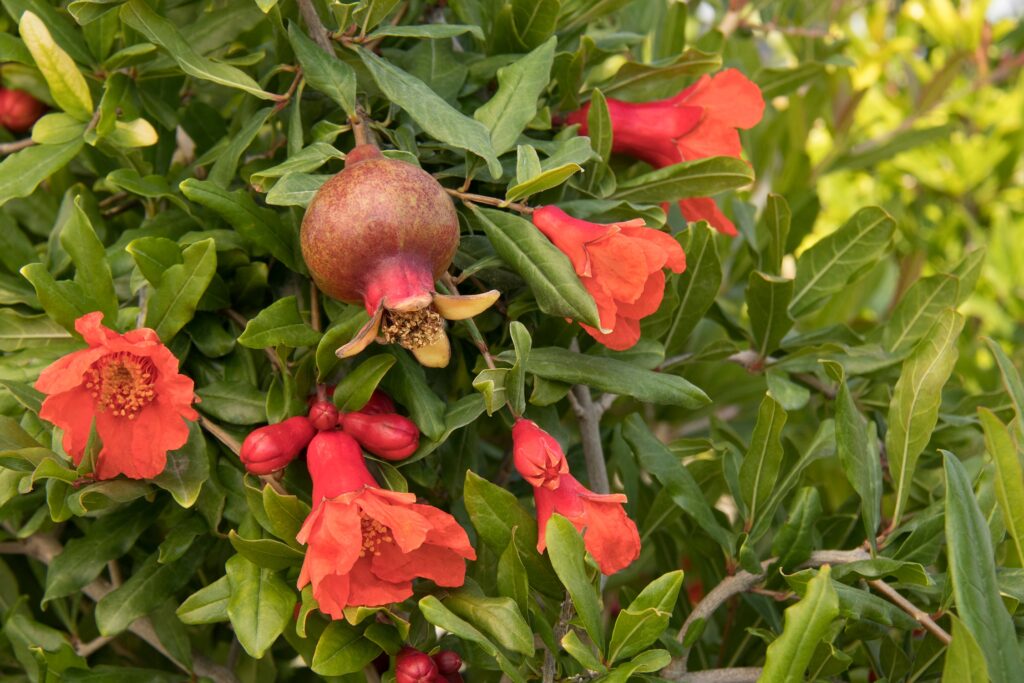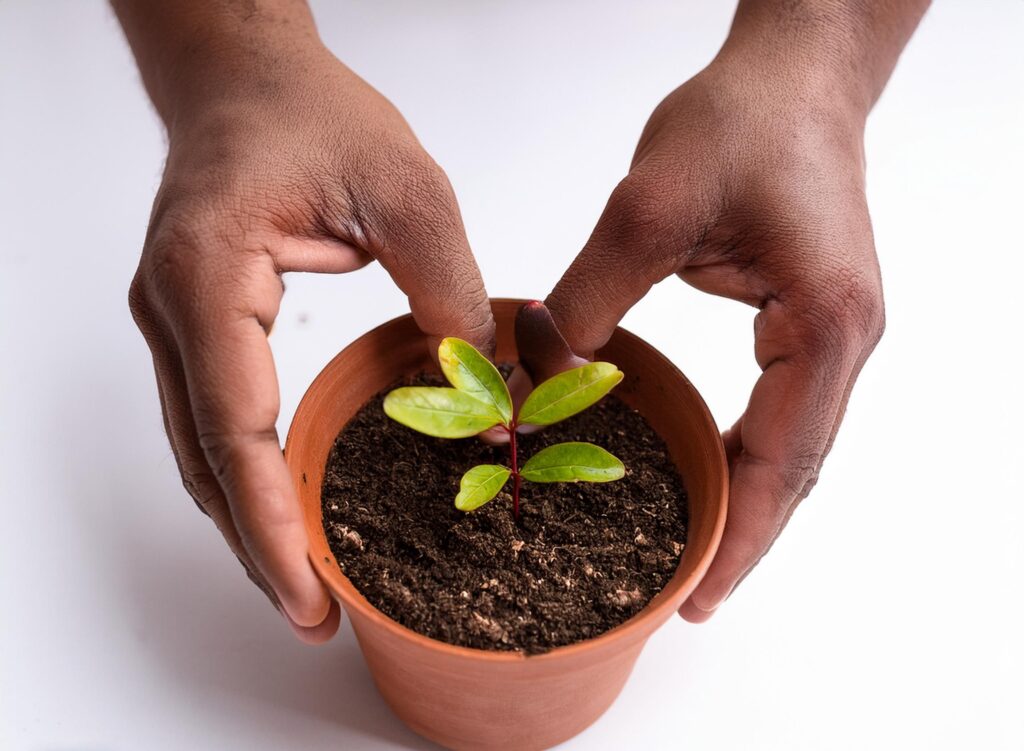Pomegranate (Punica granatum): The Jewel of the Garden
Introduction:
Pomegranate, scientifically known as Punica granatum, is a cherished fruit-bearing shrub renowned for its vibrant, ruby-red fruits and numerous health benefits. Celebrated across cultures for its beauty, symbolism, and nutritional value, the pomegranate has earned its place in gardens and landscapes worldwide. As an experienced arborist, I have observed the versatility and allure of this remarkable plant, which continues to captivate gardeners and horticulturists alike. Exploring the unique attributes, cultural significance, and ecological benefits of pomegranate provides valuable insights for those interested in cultivation and environmental stewardship.

Scientific Classification:
- Kingdom: Plantae
- Phylum: Angiosperms
- Class: Eudicots
- Order: Myrtales
- Family: Lythraceae
- Genus: Punica
- Species: P. granatum
The pomegranate belongs to the Lythraceae family, which includes a range of ornamental and fruit-bearing plants. Within its genus, Punica is known for its distinctive fruit and striking flowers. Punica granatum is the most commonly cultivated species, distinguished by its large, round fruit filled with jewel-like seeds.
Description:
- Height: Pomegranate typically grows between 3 to 6 metres tall, though in optimal conditions, it can reach up to 8 metres. This moderate height makes it suitable for both garden settings and larger landscapes, providing an attractive focal point without overwhelming the space.
- Trunk Diameter: The trunk of the pomegranate is slender and typically ranges from 5 to 15 centimetres in diameter. It is usually covered with smooth, brownish bark that provides a sturdy base for the plant’s branches and foliage.
- Leaves: The leaves of the pomegranate are small, lance-shaped, and glossy green, measuring between 3 to 7 centimetres in length. They are arranged alternately along the branches, creating a dense, lush canopy that complements the plant’s vibrant flowers and fruits.
- Flowers: Pomegranate is renowned for its striking flowers, which are usually bright orange-red and trumpet-shaped. Each flower has five petals and appears in clusters at the ends of the branches. The blooming period typically occurs in late spring to summer, with each flower lasting for a few days. The flowers are not only visually appealing but also attract pollinators such as bees and butterflies.
- Fruits: The pomegranate fruit is one of its most distinctive features. It is round and leathery, with a tough outer rind that ranges in colour from greenish-yellow to deep red. Inside, the fruit contains numerous juicy seeds, known as arils, which are encased in a translucent, red pulp. The fruit matures from late summer to autumn, offering a sweet and tangy flavour that is enjoyed fresh or used in cooking and beverages.
Distribution and Habitat:
Pomegranate is native to the region stretching from the Middle East to the Himalayas, where it thrives in hot, arid climates. Its adaptability has allowed it to spread to subtropical and temperate regions worldwide, including parts of Europe, North America, and Australia.
- Natural Habitat: In its native habitat, pomegranate is commonly found in dry, rocky soils and open areas. It prefers full sun and well-drained soil, which aligns with its ability to withstand drought and high temperatures. Its deep root system helps it access water and nutrients from the soil, contributing to its resilience in arid environments.
- Urban and Rural Landscapes: In many parts of the world, pomegranate is cultivated for its fruit and ornamental value. In India, it is frequently planted in gardens, along roadsides, and in agricultural settings. Its vibrant flowers and fruits add colour and interest to landscapes, while its drought tolerance makes it a practical choice for water-wise gardening.
Lifespan:
Pomegranate is a long-lived shrub, with a lifespan that can extend for several decades. Proper care, including regular pruning and pest management, can enhance its longevity and fruit production, ensuring that it remains a productive and attractive part of the landscape for many years.
- Growth Rate: Pomegranate has a moderate growth rate, with young plants often growing rapidly. As the plant matures, its growth rate slows, but it continues to produce fruit and flowers throughout its life.
- Maintenance: While pomegranate is relatively low-maintenance, it benefits from periodic pruning to maintain its shape and remove any dead or diseased wood. Fertilisation can also support healthy growth and fruit production, particularly in nutrient-poor soils. In areas with cold winters, protecting the plant from frost can help prevent damage.

Ecological Importance:
- Pollinator Support: Pomegranate’s bright, attractive flowers provide a valuable source of nectar for pollinators such as bees and butterflies. This pollination support is crucial for maintaining biodiversity and promoting healthy ecosystems.
- Soil Stabilisation: The deep root system of the pomegranate helps stabilise soil and prevent erosion, particularly in areas prone to soil degradation. Its presence in gardens and landscapes can contribute to soil health and stability.
- Air Purification: Pomegranate plants contribute to air quality improvement by absorbing carbon dioxide and releasing oxygen. Their ability to thrive in urban environments also helps mitigate the effects of air pollution, making them a beneficial addition to city landscapes.
Cultural Significance:
Pomegranate holds a prominent place in various cultures and religions, symbolizing fertility, abundance, and immortality.
- Religious Use: In many cultures, pomegranate is considered a symbol of life and fertility. In Hinduism, the fruit is often used in religious rituals and ceremonies, representing prosperity and abundance. It is also mentioned in ancient texts and traditions, reinforcing its importance in cultural practices.
- Folklore: The pomegranate is associated with numerous myths and legends, often symbolising the cycles of life and death. In Greek mythology, the fruit is linked to the story of Persephone and the changing seasons, highlighting its role in folklore and cultural narratives.
Threats and Conservation:
- Pest and Disease: While generally resilient, pomegranate can be susceptible to pests such as aphids, pomegranate worms, and fungal diseases. Integrated pest management practices and regular monitoring can help protect the plant and ensure its health.
- Conservation: Conservation efforts for pomegranate focus on sustainable cultivation practices and protecting its natural habitats. Promoting awareness about the plant’s ecological benefits and encouraging responsible gardening practices contribute to its conservation.
Facts about Pomegranate:
- Nutritional Benefits: Pomegranate is renowned for its health benefits, including high levels of antioxidants, vitamins, and dietary fibre. Its consumption has been linked to improved heart health, reduced inflammation, and other positive health effects.
- Culinary Uses: The seeds of the pomegranate, or arils, are widely used in cooking and beverages. They add a burst of flavor and color to dishes, from salads to desserts, and are also used to make pomegranate juice and sauces.

Planting Tips:
- Site Selection: Choose a sunny location that receives at least 6 hours of direct sunlight per day. Pomegranate thrives in bright light, which supports healthy growth and fruit production.
- Soil Preparation: Pomegranate prefers well-drained soil with a pH range of 5.5 to 7.0. Enriching the soil with compost or organic matter can improve its fertility and drainage.
- Watering: Water pomegranate regularly during the initial growth phase to establish a strong root system. Once established, the plant is drought-tolerant but may benefit from occasional deep watering during prolonged dry periods.
- Pruning: Regular pruning is essential to maintain the plant’s shape and promote healthy fruit production. Prune in late winter or early spring, removing any dead or crossing branches and shaping the plant as needed.
Conclusion:
Pomegranate (Punica granatum) is a remarkable plant that offers a combination of beauty, nutritional value, and ecological benefits. Its vibrant flowers, nutritious fruits, and cultural significance make it a valuable addition to gardens and landscapes. By understanding its needs and appreciating its role in the environment, we can enjoy the many rewards that pomegranate has to offer. Whether you are a seasoned gardener or a beginner, the pomegranate is a plant that promises both aesthetic appeal and practical benefits, enriching our lives and landscapes for years to come.